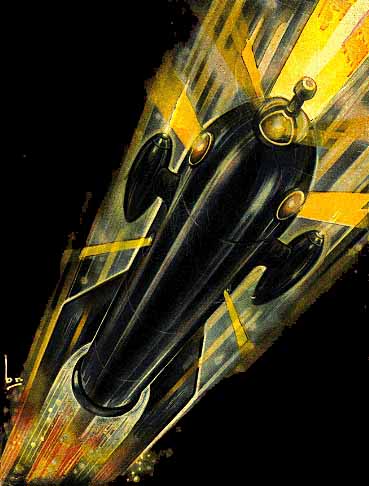
FROM CYRANO TO JEAN-LUC PICARD
PART I:
The Conquest of Space

FROM CYRANO TO JEAN-LUC PICARD
PART I:
The Conquest of Space
Contrary to popular belief, Man's conquest of space did not begin in the mid-20th century, but long before. In
fact, as this article will show, there are accounts of Man's first, timid steps nto space as early as 160 A.D.!
 This is not surprising, since man's eyes turned toward the heavens as soon as
he stepped out of the caves. Further, reliable accounts from chroniclers such as H. P. Lovecraft and Robert E. Howard (among others), who thoroughly
researched ancient civilizations, show that Man was also visited by a variety of celestial beings. So what would
be more natural than wanting to explore the very skies from which they descended?
This is not surprising, since man's eyes turned toward the heavens as soon as
he stepped out of the caves. Further, reliable accounts from chroniclers such as H. P. Lovecraft and Robert E. Howard (among others), who thoroughly
researched ancient civilizations, show that Man was also visited by a variety of celestial beings. So what would
be more natural than wanting to explore the very skies from which they descended?
The accounts of what we shall call "Proto-Space Travel" are many -- as are those of further encouters
with alien beings. For example, the notorious Micromegas, a giant alien from Sirius, accompanied by an equally
gigantic Saturnian, visited Earth in 1752, and conversed with the highly cartesian, rational writer, François-Marie
Arouet, a.k.a. Voltaire.
Yet, the laws of physics and recent astronomic discoveries about other planets would seem to contradict many of
these reports.
 While it is true that some
reports may only be flights of fancy, delusions, or attempts to cash in on another person's success story, most
are written factually, almost in a journalistic style, with great efforts spent to convince the reader of the veracity
of the account. Certainly, testimonies from a variety of enlightened figures, such as Johannes Kepler, a founding
father of astronomy, or Voltaire, a guiding ligt of the Age of Reason, to name but two, cannot be casually dismissed.
While it is true that some
reports may only be flights of fancy, delusions, or attempts to cash in on another person's success story, most
are written factually, almost in a journalistic style, with great efforts spent to convince the reader of the veracity
of the account. Certainly, testimonies from a variety of enlightened figures, such as Johannes Kepler, a founding
father of astronomy, or Voltaire, a guiding ligt of the Age of Reason, to name but two, cannot be casually dismissed.
Therefore, if we accept the truth that at least a number of reports of proto-space travel are real, we are then
forced to consider the astounding notion that, while the laws of physics remain unchanged, the characteristics
of Earth's Outer Space may have been different in the past from what they are today...
But before we engage in speculations, let us first examine the evidence.
1. PROTO-SPACE TRAVEL
In this section, we shall review, in chronological order, the most notorious -- and likely to be real -- instances
of proto-space travel.
 160 A.D.
160 A.D.
Lucian of Samosata wrote the first account of what may well be Man's first
journey into space, Icaromenippus, in
which a new Icarus, a man named Menippus, told him how he used a sophisticated winged apparatus that combined the
wings of eagles and vultures to reach our satellite, or at least a floating object located "three thousand
furlongs away"... The place that Menippus reached is described as a rocky spot. All this leads us to speculate
that Menippus may not, in fact, have reached the Moon as Lucian believed, but one of the floating islands located
in the upper strata of Earth's atmosphere, à la Laputa, later described in great detail by Jonathan Swift in his report on Gulliver's
Travels.
Lucian's report was likely poorly received by the masses, for he reworked the same yarn in his later Vera Historia, but this time making it far more exciting,
casting Ulysses as the hero, adding plenty of adventure (flying ships and other worlds in space), and trying to
pass it off as a "missing chapter" of Homer's best-selling Odyssey.
Vera Historia is a better read and, in
some respects, perhaps a more prophetic one, but it sounds like made-up fiction, while Icaromenippus reads like a true account. Was Menippus the first man to have effectively ascended to the
Heavens?... We shall never know for certain...
 1634
1634
A far more credible account of proto-space travel is the one written by the
noted astronomer Johannes Kepler,
who in Somnium reported the story told
to him by a mysterious Icelandic man named Duracotus -- a self-proclaimed student of Tycho Brahe -- who claimed
to have travelled to the Moon.
In truth, Duracotus revealed to Kepler that he was carried there by winged Selenites, who trafficked with his mother,
a notorious witch. But what gives this account an undisputable ring of truth is that Duracotus explained to Kepler
that these "demons" had to devise ways to accommodate the human's need for air and his intolerance of
extreme cold. These were taken care of through the use of a sleeping potion and moistened sponges pressed against
his face. Duracotus also noted his passage through the point where the gravity of Earth and of the Moon balanced
each orther.
These details, magnified by the scrutiny of such a renowned scientist as Kepler, make us believe the basic veracity
of Duracotus' account, and give us our first glimpses into the reality of Outer Space as it might have been at
the time, and the creatures which dwelled therein.
1638
Bishop John Wilkins's A Discourse Concerning
a New World and Another Planet acknowledged his debt to Kepler's Somnium. This very successful book, reprinted in 1640,
concerned itself with the need to manufacture "flying chariots" to go and colonize our satellite. Wilkins
took the idea of space travel very seriously, and approached it with great scientific discipline and unbound enthusiasm
and faith in man's ultimate conquest of space, but ultimately it was nothing more than prospective fiction.
Francis Godwin's notorious The Man in the Moone,
coincidentally published the same year, and released under the pseudonym of "Domingo Gonzales" (the name
of the story's hero), in which the protagonist use trained swans to fly to the Moon, was pure and simple fiction,
with no pretense otherwise.
2. FIRST ENCOUNTERS
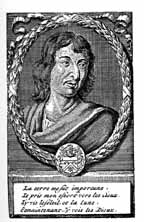 Duracotus was abducted by aliens, and therefore did not travel to the Moon under his own
power. The honor of being Mankind's first envoy to the Outer Worlds therefore fell to French nobleman Hercule Savinien Cyrano de Bergerac.
Duracotus was abducted by aliens, and therefore did not travel to the Moon under his own
power. The honor of being Mankind's first envoy to the Outer Worlds therefore fell to French nobleman Hercule Savinien Cyrano de Bergerac.
(The fact that Cyrano de Bergerac indeed deserved that honor was attested by Robert Heinlein in several of his
works.)
In his Histoire des Etats et Empires de la Lune
(History of the States and Empires of the Moon),
published posthumously in 1657, followed by Histoire des Etats et Empires du
Soleil (History of the States and Empires
of the Sun) (1662), both eventually collected as L'Autre Monde (Other
Worlds), De Bergerac developed the concepts of rocket power, and not only
of rockets, but of the use of second-stage rockets. His account is, in fact, the first description of a manned
rocket flight in literature.
(An English translation
of Cyrano's account by Don Webb can be found on the Bewildering Stories site.)
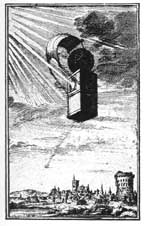 De Bergerac also lavishly detailed other fanciful "methods" of space
travel, but undoubtedly these were included in the novel purely to obfuscate the nature of the real means employed
to reach the Moon, and perhaps also to make the book more entertaining, and therefore more commercial.
De Bergerac also lavishly detailed other fanciful "methods" of space
travel, but undoubtedly these were included in the novel purely to obfuscate the nature of the real means employed
to reach the Moon, and perhaps also to make the book more entertaining, and therefore more commercial.
Another remarkable feature of De Bergerac's account, which gives it additional weight, is his elaborate description
of the alien societies that he encountered on his journeys, such as that of the Bird-Men who live on the "dark
side" of the Sun and hate men. (Very likely an alien colony established on Mercury -- could these be related
to the winged, space-faring aliens described by Howard in Tower of the Elephant?)
Thanks to De Bergerac, we first learned that Man was not only no longer the sole sentient species in the universe,
but that in fact he was not even the most important one!
This stunning revelation, taken in the religious context of the times (let us remember that 500 persons suspected
of witchcraft and heresy were burned at the stake in Rouen in 1670!), help explain why the wise De Bergerac embellished
the true story of his space journey with many fantasyish details à la Godwin, and why he waited until after he was dead to have his accounts published.
As a footnote here, we should mention that Charles Sorel, a contemporary of Cyrano de Bergerac, who reportedly
knew him and may have been in on the real nature of his journeys, wrote in his Récit
du Voyage de Brisevent (Tale of Brisevent's
Journey) in 1642 (just about the time when De Bergerac travelled to Outer
Space): "Some men have affirmed that there are many worlds, which some
have placed in the planets, and others in the fixed stars; for my part, I believe there is a world on the moon." And further predicted that a "Prince as ambitious
as Alexander, who shall come to conquer this world," would do so using
"great engines, to descend or ascend."
After De Bergerac, space travel became more common, but it is often hard to separate real accounts from fanciful
ones.
1666
Margaret Cavendish in The Blazing World wrote about the first woman space traveller, who made the round of the Moon and the other
planets, but I don't know enough about her work to properly assess its veracity.
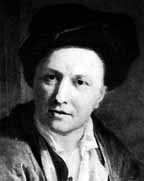 1686
1686
It would not be, however, too surprising if Ms. Cavendish's account (and indeed,
others we know nothing of) were indeed true, since Bernard Le
Bovier de Fontenelle wrote his ground-breaking Entretiens
sur la Pluralité des Mondes (Conversations
on the Plurality of Worlds), a documentary treatise about life on other planets
which speculated on what the inhabitants of each world might be like. Certainly, a research like that could only
be of use to starfarers...
As further evidence of secret and not-so-secret space travel, let us note that France, Germany (in 1668) and Russia
(in 1680, when Czar Peter the Great established a rocket factory in Moscow) all began to experiment with rockets
after De Bergerac's journeys. And of course, the year De Fontenelle wrote his treatise was also the year when Isaac
Newton published his Principia, in which
the laws of motion and gravity were outlined...
The space race had begun.
3. THE FIRST SPACE RACE
We should skip Jesuit Gabriel Daniel's purely polemical Voyage du Monde de
Descartes (1690). and David Russen's Iter
Lunaire (in which a combination of springs and pullies was used to reach the
Moon!), for the clearly-labeled fantasies they were. (Either that or Russen worked hard to make people believe
De Bergerac's accounts were a farce.)
 1705
1705
Far more interesting, and fully consistent wih the notion of a space race,
journalist Daniel Defoe,
chronicler of the adventures of the notorious Robinson Crusoe, in The Consolidator, described the discovery of the eponymous spaceship, invented 2,000 years before the Flood
by a Chinese scientist named Mira-cho-cho-lasmo. The Consolidator is a flying machine powered by an internal combustion engine, that also featured hibernation
capsules to ease the tedium of long, dangerous space flights. The Consolidator is the Roswell of the 18th century.
Let us further ponder the fact that, on May 2, 1726,
the following advertisement was placed in the Country Gentleman of London:
"The famous Planetarey Caravan, which I spoke of before, being now entire
finish'd and render'd convenient for all such Persons who have any Desire to visit the Moon, Venus, Mercury, or
any other of the Planets.." (the ad goes on to state where the Caravan
presently is located, then mention the fares, based on the distances travelled) "In
the same Place also, may be seen the Planetarey Curricule, which is a Vehicle prepar'd only for Two Persons..."
The most interesting feature of this advertisement is that, when the distance to the Moon is worked out, based
upon the fares given, it comes exactly to 240,000 miles!
1728
Murtagh McDermot's A Trip to the Moon was a bizarre return to the theme of alien abduction, in which a man was taken to the Moon
by an artificial whirlwind. Once there, however, friendly Selenites helped him return to Earth in a barrel-shaped
ship, launched from a gun barrel dug one-mile deep into the lunar soil, and using a powder train a mile long to
ignite it. One is easily led to speculate that such technology was then adapted and reused 137 years later by the
pioneers of the American Gun-Club.
1741
The anonymous A New Journey to the World
in the Moon described a spaceship clearly built according to the specs of
the Consolidator, and went on to detail
the conditions of Outer Space and the difficulties of travelling through it.
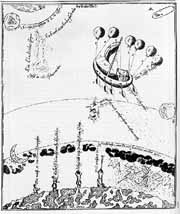 1745
1745
German writer Eberhard Christian Kindermann's Swift Journey by Airship to the Upper World may have been
intended to record the first German space travel to the Moon, and then to Mars, but because it used a balloon-powered
gondola, one is inclined to dismiss it as pure fiction, unless it was purposefully camouflaged as such. (One may
want to add in this category Rudolph Erich Raspe's notorious travels of his fictional Baron of Munchausen from
1785.)
1761
On the other hand, De Listonal's space "galley" described in Le Voyageur
Philosophe dans un Pays Inconnu aux Habitants de la Terre (The Philosophical Traveler In A Country Unknown From The Inhabitants Of Earth) was secretly assembled by an international crew in an undisclosed location, and featured
a full crew, complete with pilot and astronavigator. The purpose of its journey was more commerce with the Selenites.
By the mid-to-late 18th century, alien encounters, either on Earth or in Outer Space, had become fairly frequent.
Among these, we should record the Chevalier de Béthune's Relation du
Monde de Mercure (Tale Of The World Mercury) (1750), another description of the colony of immortal, winged beings inhabiting the planet
Mercury; Voltaire's own close encounter with the alien Micromegas from Sirius (1752); Charles-François Tiphaigne
de la Roche's traffics with Zamar the Selenite, detailed in In Amilec (1754); Marie-Anne de Roumier-Robert's Voyage de Milord
Céton dans les Sept Planètes (Voyage
Of Lord Ceton In The Seven Planets) (1765), in which Lord Ceton and his sister
Monime travel to seven different planets "on the wings of the angel Zachiel."
 In 1775, chemist Louis-Guillaume de La Follie's Le Philosophe sans Prétention (The Philosopher Without Pretention) recorded the visitation
of Earth by a crew of Mercurian scientists led by one Scintilla (who had been in telepathic contact with Earthmen
before), who came to our planet in an electric-powered starship, using static electricity, not unlike the infamous
Daleks).
In 1775, chemist Louis-Guillaume de La Follie's Le Philosophe sans Prétention (The Philosopher Without Pretention) recorded the visitation
of Earth by a crew of Mercurian scientists led by one Scintilla (who had been in telepathic contact with Earthmen
before), who came to our planet in an electric-powered starship, using static electricity, not unlike the infamous
Daleks).
Until then, space travel had been the exclusive province of scientists and philosophers, who had meekly approached
other species, aware of Earth's lower status. This was going to change during the course of the 19th century...
As the 18th century ended, the French Revolution crippled space travel in France. In the early 1790s, the noted
utopist, playwright, and journalist Louis-Abel Beffroy de Reigny, better known as "Cousin Jacques", wrote
a number of plays taking place on other planets, but these were merely satires, bitter-sweet dreams of what once
was or might have been... The future of space travel in the 19th century was to be found in England, and America.
4. PUSHING OUTWARD
The 19th Century showed the beginning of an aggressive push by Mankind into Outer Space, driven by the same type
of impulses which had compelled the European powers to colonize most of Asia and Africa. However, it is worth noting
that space travel remained, for the most part, the province of individuals or companies, not governments.
1815
Edward Francesca Burney's account, Q.Q. Esq.'s Journey to the Moon, reported on a journey to the Moon undertaken by a man known only as Q.Q. in a conical capsule
launched by four cannons. Undoubtedly, this can be seen as a prelude to the famous Gun-Club enterprise, fifty years
later.
1827
America entered the space race in a big way, and yet the events we are about
to record would lead to two divergent paths for space travel.
A professor at the University of Virginia, George Tucker (who taught Edgar Allan Poe), writing under the pseudonym
of "Joseph Atterley", recorded the first American trip to the Moon in A
Voyage to the Moon. A truncated, cubic spaceship, propelled by the newly-discovered,
gravity-repulsing substance, Lunarium, was used to dispatch a crew to the Moon. More about the origins of Lunarium
below...
However, there were various technological problems with the use of Lunarium, as is always the case with emerging
technologies. In fact, Lunarium technology would not be perfected until Professor Cavor in the early days of the
next century. Also, the huge financial interests of the competing gun manufacturers helped suppress research into
Lunarium, to the clear advantage of gun-driven or rocket-powered technologies.
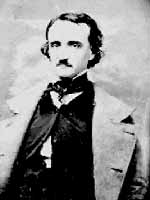 1835
1835
Edgar Allan Poe's renowned
account of The Unparalleled Adventures of Hans Pfaal
is capital on several accounts. First, the report is crowded with numerous scientific and astonomical details that
attest to its authenticity. While certain key facts were obviously kept hidden, disguised, or obfuscated by Poe,
it also provides further evidence that Earth's atmosphere extended, albeit in extreme tenuity, nearly as far as
the Moon -- as previously discovered by Kepler.
Finally, one is led to wonder if the protagonist "Hans Pfaal", fleeing his creditors, is in fact none
other than Poe himself. Certainly a student of George Tucker would have been greatly motivated to embark on a space
journey of his own, and it is equally possible that one of the purposes of this journey was to further develop
Lunarium research. In fact, could have Poe been murdered by gun-makers in an attempt to prevent further research
into Lunarium?...
We should dismiss here as clearly fictional J. L. Riddell's Orin Lindsay's
Plan of Aerial Navigation (1847), in which the hero was dragged off in space
by a comet (unless it is yet another case of alien abduction?); Charles Rumball (writing as "Charles Delorme")'s
The Marvellous and Incredible Adventures of Charles Thunderbolt in the Moon (1851), a children's novel which featured a steam-driven spaceship; Louis Desnoyers' Les Aventures Amphibies de Robert-Robert et de son fidèle compagnon Toussaint Lavenette (The Amphibian Adventures Of Robert-Robert And His Faithful
Companion Toussaint Lavenette) (1853), and Alfred Drious's Les Aventures d'un Aéronaute Parisien dans les Mondes Inconnus
(The Adventures Of A Parisian Aeronaut In The Unknown Worlds) (1856) both of which featured protagonists reaching the Moon via hot air balloon.
 1860
1860
More evidence of secret research into Lunarium technology, possibly sent to France by Poe via his renowned translator,
poet Charles Baudelaire, can be found in Alexandre Dumas's novella "Voyage à la Lune" (Trip To The Moon),
in which our satellite was reached by a spacecraft powered by an unnamed substance (hint, hint!) "repelled
by the Earth". Both Poe and Dumas, as one will recall, were men who had been in contact with the mysterious
figure known diversely as Joseph Balsamo, Arthur Gordon Pym and Count of Monte-Cristo, who himself was in possession
of alien technology, which may in fact explain the origin of the Lunarium in the first place. (See our companion
article, Who Was Nobody?).
It is not altogether surprising to find them both, once again, linked in such a fashion.
But the gun and rocket manufacturers would not so easily be disarmed -- no more than lighter-than-air partisans
would, until the same man, now known as Nemo or Robur, would prove once and for all the superiority of heavier-than-air
flying machines.
Two ground-breaking attempts were going to be ushering a new age in space conquest at the end of the 19th century:
one based in France, the other in America.
5. THE INDUSTRIAL SPACESHIP HAS ARRIVED
Coincidentally, both attempts took place in 1865, and were reported by French writers.
The first, and historically least important, was chronicled by Achille Eyraud in his Voyage
à Vénus (Voyage to Venus). In it, a French spaceship propelled by a "reaction engine," which some genre scholars
construed as a kind of multi-stage rockets, managed to reach the planet Venus, the seat of peaceful society, in
which the sexes were equal and solar-powered robots toiled in the fields. But the technology described by Eyraud
proved far too imperfect and problematic, and was abandoned.
 Far more successful was the American Gun-Club's $5 million space travel enterprise described in great
detail by Jules Verne in
his De la Terre à la Lune (From the Earth to the Moon). A projectile containing Americans
Barbicane and Nichols, and daring Frenchman Michel Ardan, was fired from a giant cannon located in Florida. Their
return to Earth was chronicled in Autour de la Lune
(Around the Moon), published in 1870.
Far more successful was the American Gun-Club's $5 million space travel enterprise described in great
detail by Jules Verne in
his De la Terre à la Lune (From the Earth to the Moon). A projectile containing Americans
Barbicane and Nichols, and daring Frenchman Michel Ardan, was fired from a giant cannon located in Florida. Their
return to Earth was chronicled in Autour de la Lune
(Around the Moon), published in 1870.
Because of the huge publicity given to the event by the American business community, the Gun-Club's journey was
largely perceived as a huge success, in spite of the fact that it achieved very little. Yet, because of this publicity,
there is powerful evidence that the entire history of rocketry and space travel would have continued to remain
mired in isolated, even amateurish, attempts, had not this trip taken place.
One might even go as far as stating that it was that first aggressive foray into space by gun-makers and conquerors
that was responsible, as we shall speculate below, for events of cosmic magnitude throughout the Solar System.
 For, by the time Barbicane, Nichols and Ardan reached the Moon, our satellite had obviously
been abandoned by the races that once lived on it. Only ruins remained on the surface. Some Selenites, as Professor
Cavor eventually discovered, chose a temporary refuge under the Moon's surface. Others simply retreated to the
Outer Planets. One can only assume that such a drastic move was the direct consequence of Industrial Revolution-Man's
aggressive push into space.
For, by the time Barbicane, Nichols and Ardan reached the Moon, our satellite had obviously
been abandoned by the races that once lived on it. Only ruins remained on the surface. Some Selenites, as Professor
Cavor eventually discovered, chose a temporary refuge under the Moon's surface. Others simply retreated to the
Outer Planets. One can only assume that such a drastic move was the direct consequence of Industrial Revolution-Man's
aggressive push into space.
Second, one might also speculate on the technologies actually employed by the Gun-Club. Verne, who was shown in
our companion article to have purposefully (if clumsily) disguised the true records of Arthur Gordon Pym and Captain
Nemo (see Who Was Nobody?)
also obfuscated certain facts about some of the top secret methods employed by the Gun -Club, such as the identity
of the metal alloys used for the projectile (likely tungsten steel), and the presence of some form of inertia-compensating
device.
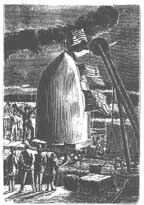 This secrecy is due to the fact that, as aliens were progressively moving out
of the way of the expanding human race, certain physical characteristics of Outer Space (such as the presence of
a tenuous atmosphere between Earth and the Moon recorded by Poe and others) were, undoubtedly much to the surprise
of human scientists, also changing.
This secrecy is due to the fact that, as aliens were progressively moving out
of the way of the expanding human race, certain physical characteristics of Outer Space (such as the presence of
a tenuous atmosphere between Earth and the Moon recorded by Poe and others) were, undoubtedly much to the surprise
of human scientists, also changing.
The publicity machine of the Gun-Club, and the Governments behind them, could not have Earth's populace become
aware of such realities, and once again, Verne collaborated by publishing a heavily sanitized version of the truth.
As we said at the beginning of this article, the moment has therefore come to reconcile the reality of proto-space
travel and early space journeys with the notion that, while the laws of physics remain unchanged, the characteristics
of Earth's Outer Space may have been different in the past from what they are today.
We now know that Earth -- indeed the entire Solar System -- actually travels through space. We shall therefore
hypothesize that, in centuries past, the Solar System crossed a region of space presenting different physical characteristics,
from which it emerged only (and progressively) after, and as a result of, the Gun-Club space travel of 1865.
We shall dub this space: "Aether Space."
6. AETHER SPACE
While our knowledge, and understanding, of Aether Space is by force limited, a careful study of the various reports
we have just reviewed enable us to form a general idea of its nature.
First and foremost, as we have seen, Aether Space was inhabited.
Previously in this article, we have reported on numerous instances of recorded contacts between Men and Aliens,
dating as far back as the early 1600s.
 Let us add that the eminent American writer Charles
Fort long suspected that Earth was not unlike a small primitive island in
space, a space inhabited by unimaginable beings, crossed by inconceivable vehicles, who occasionally dumped their
refuse on our planet, or interacted with us as we interact with monkeys or cattle.
Let us add that the eminent American writer Charles
Fort long suspected that Earth was not unlike a small primitive island in
space, a space inhabited by unimaginable beings, crossed by inconceivable vehicles, who occasionally dumped their
refuse on our planet, or interacted with us as we interact with monkeys or cattle.
Similar descriptions of the universe, as we have seen, also arise from the various reports written by H. P. Lovecraft
and, as we have already pointed out, Robert E. Howard's accounts of the long-dead Hyborian Age.
The concept of Earth not being alone in a cosmic void devoid of life, but on the contrary sharing its space with
a solar system teeming with other lifeforms can also be found in a variety of other research works, from the notorious
Madame Blavatsky's The Secret Doctrine,
to Christian author C. S. Lewis' Out of the Silent Planet, to Maurice Renard's ground-breaking Le
Péril Bleu, and more.
Even today, many who believe in aliens, believe that Man is not alone, and is either manipulated by higher beings,
or projects upon them a variety of illusions reflecting his inner beliefs rather than true reality.
 And, as we have noted, the artefacts of Madame Blavatsky's alien "Dzyan" found
in the Antarctic, also played a major part in the life of the man known as Nemo, as outlined in our companion article,
Who Was Nobody?
And, as we have noted, the artefacts of Madame Blavatsky's alien "Dzyan" found
in the Antarctic, also played a major part in the life of the man known as Nemo, as outlined in our companion article,
Who Was Nobody?
Second, Aether Space was different from regular space.
Many of the reports we have studied indicate the existence of a form of atmosphere extending beyond Earth's immediate
boundaries, as well as the presence of gaseous "pockets" in space. Planetary conditions on Mars, Venus,
Mercury, etc. as reported were equally different from the ones found in modern times. Finally, some of the laws
of physics did not appear to be identical to what we know, or at the very least seemed to be working differently.
All this leads us to speculate that perhaps certain regions of space may be more "porous" than others...
Gravity not being quantic in nature would remain the same for humans bound to the planetary surface, but a weaker
gravity would not be as strong a glue once outside of Earth's attraction... Were the Planck's constant ever so
slightly different, the speed of light would actually increase, making space travel more practical... Etc., etc.
In short, Aether Space then may well have
been different from Outer Space now.
Our final speculation, by far the most daring, would be to ask whether Aether Space was a natural phenomenon, or
an artificial one?
 Could vast, cosmic intelligences, such as, or even beyond Lewis' Eldils, have decided the
move Aether Space beyond the confines of the Solar System, once man's incursions into space became both frequent
and aggressive?
Could vast, cosmic intelligences, such as, or even beyond Lewis' Eldils, have decided the
move Aether Space beyond the confines of the Solar System, once man's incursions into space became both frequent
and aggressive?
Could it be possible that, what was once a thriving, planet-spanning, cosmic eco-system just packed its bags and
left (with a few exceptions, as we shall see), leaving behind it a barren collection of dead worlds and cold, hostile,
airless void, stripped of its wonderful properties?
In effect, has Mankind been effectively quarantined?
ALSO READ "MARS À L'OMBRE" FOR MORE ABOUT
EARTH AND MARS
TO READ PART II:
MANIFEST DESTINY